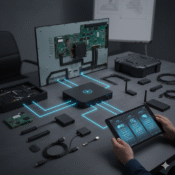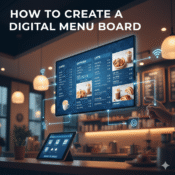
How To Create a Digital Menu Board?
In today’s fast-paced retail and hospitality industries, digital menu boards have become an essential communication and marketing tool. From quick-service restaurants (QSRs) and coffee shops to convenience stores and corporate cafeterias, businesses are adopting digital signage menus to modernize their operations, captivate customers, and streamline menu management.
Digital menu boards not only enhance the customer experience but also allow businesses to update content in real time, promote specials, and increase average order value. In this guide, we’ll explore How To Create a Digital Menu Board that combines smart design, reliable technology, and effective content management.
As a trusted name in digital signage innovation, ScreensHub provides tailored digital menu board solutions designed to help businesses deliver visually appealing, dynamic, and efficient menu displays that drive results.
Understanding Digital Menu Boards
What Is a Digital Menu Board?
A digital menu board is a screen-based display that showcases menu items, pricing, and promotional content using digital signage technology. Unlike printed menus, digital boards can display ?, including videos, animations, and real-time updates.
Key Types of Digital Menu Boards
- Static Digital Menus – Electronic versions of printed menus, ideal for stable menus with occasional updates.
- Dynamic Digital Menus – Feature videos, animations, and motion graphics to highlight products or promotions.
- Interactive or Touchscreen Menus – Allow customers to browse items, view nutritional details, and customize orders.
Advantages Over Traditional Menus
- Real-Time Updates: Instantly change prices or add limited-time offers.
- Higher Engagement: Motion and visuals grab attention.
- Cost Efficiency: Reduce printing and replacement costs.
- Brand Consistency: Maintain uniform content across all locations.
ScreensHub’s digital signage menu systems combine powerful content management tools with sleek design to help businesses transform their customer experience and marketing capabilities.
Planning Your Digital Menu Board
Define Your Goals
Before creating a digital menu board, outline your objectives. Are you aiming to:
- Increase sales through upselling and promotions?
- Improve order accuracy and customer flow?
- Enhance your brand’s visual appeal?
Setting clear goals ensures that your design and content strategy align with business priorities.
Understand Your Audience and Environment
The placement and content of your digital menu should reflect the habits and expectations of your audience. For example:
- QSRs need fast decision-making layouts.
- Cafés can use more visual storytelling.
- Corporate cafeterias might include nutritional information.
Choose the Right Hardware
Select high-quality screens that ensure durability and visibility. Options include:
- LED Displays for brightness and energy efficiency.
- LCD Screens for detailed visuals and affordability.
- Outdoor Displays for drive-thrus or exterior installations.
ScreensHub provides consultation services to assess your space, recommend ideal screen sizes and placements, and ensure optimal visibility for your customers.
Digital Menu Board Design Principles
Keep It Clean and Readable
A well-structured layout allows customers to make decisions quickly. Avoid overcrowding by grouping items logically (e.g., beverages, mains, desserts).
Choose the Right Fonts
Typography should be clear, legible, and consistent with your brand. Sans-serif fonts like Helvetica or Roboto work well for digital displays.
Use Colors Strategically
Color choices should align with your branding and enhance readability. Use contrast between background and text for maximum visibility.
Incorporate High-Quality Visuals
High-resolution images and short video clips of your dishes can significantly influence purchase decisions. Motion graphics can add appeal but should not distract from menu readability.
Highlight Key Items
Promote high-margin or popular items using larger text, contrasting colors, or animation effects.
Brand Consistency
Include your logo, colors, and tagline to ensure that every digital menu reflects your identity.
ScreensHub offers customizable digital menu templates and expert design support, helping brands craft visually compelling menus that are easy to navigate and update.
Content Creation and Management
Craft Compelling Descriptions
Menu descriptions should be concise and persuasive. Focus on sensory appeal—use descriptive language that evokes taste and quality.
Balance Text and Visuals
Avoid clutter by pairing text with strong visuals. Use spacing effectively to direct attention and maintain flow.
Dynamic Content Scheduling
Rotate your menu content based on time of day or season—display breakfast menus in the morning and dinner specials at night.
Integration with POS Systems
Integrating your menu board with your point-of-sale (POS) system allows real-time updates on pricing, item availability, and promotions.
Easy Remote Updates
With ScreensHub’s cloud-based CMS (Content Management System), you can update menus across multiple locations instantly. This ensures consistency, saves time, and reduces manual errors.
Technical Setup and Software Selection
Choose Reliable Digital Menu Board Software
Your software should be intuitive and robust. Key features to look for include:
- Playlist Automation: Schedule content for specific times.
- Multi-Screen Management: Manage multiple menus from one dashboard.
- Real-Time Reporting: Track which content performs best.
- Analytics Integration: Gain insights into customer engagement.
Scalability and Compatibility
Ensure the software supports future expansion—adding new screens or locations should be seamless. Compatibility with existing hardware and network infrastructure is equally important.
ScreensHub’s software platform provides a user-friendly interface, comprehensive control over content scheduling, and dedicated customer support for smooth operation.
Installation and Deployment
Best Practices for Screen Placement
Position screens at eye level for optimal visibility. Consider ambient lighting—avoid glare from windows or overhead lights.
For drive-thrus, use weather-resistant outdoor screens with high brightness.
Network and Security Setup
Use secure network connections and access controls to protect your digital signage system. ScreensHub ensures all installations follow industry-standard security protocols.
Testing Before Launch
Test the system thoroughly to verify that visuals display correctly, animations run smoothly, and scheduled content updates as intended.
ScreensHub’s installation and maintenance team manages every phase—from setup to calibration and ongoing support—ensuring your system performs flawlessly from day one.
Measuring Success and Optimization
Key Performance Indicators (KPIs)
Track measurable outcomes to assess the success of your digital menu board:
- Sales Lift: Increased revenue from featured items.
- Engagement Metrics: Time spent viewing screens or interactive elements.
- Operational Efficiency: Reduced order times or errors.
Use Analytics for Continuous Improvement
Monitor viewer behavior and screen performance through integrated analytics. Test different menu layouts, visuals, or promotions to see which generates the best response.
A/B Testing for Content Refinement
Experiment with variations in design, color, or featured items to identify what resonates best with your audience.
ScreensHub’s analytics tools empower clients to make data-driven optimizations, ensuring digital menus remain fresh, relevant, and impactful.
Future Trends in Digital Menu Boards
AI-Driven Personalization
Artificial intelligence will enable menus that adapt in real time—showing recommended items based on time, weather, or customer behavior.
Mobile and QR Code Integration
Customers can access menus on their smartphones through QR codes, enabling contactless ordering and payments.
Interactive Touchscreen Menus
Touch-enabled displays are transforming QSRs and self-service environments, allowing customers to customize orders and explore detailed menu information.
Sustainability and Paperless Operations
Digital menu boards reduce paper waste and contribute to eco-friendly business practices, aligning with global sustainability goals.
ScreensHub continues to lead in innovation, offering future-ready digital menu solutions that evolve with emerging trends in technology and customer experience.
Conclusion
Creating an effective digital menu board involves thoughtful planning, smart design, and the right technology. When executed well, it enhances brand presence, accelerates sales, and simplifies operations.
From strategy and design to installation and analytics, ScreensHub delivers comprehensive digital menu board solutions that help businesses modernize their menu presentation while maintaining operational flexibility.
Whether you’re a small café or a global QSR chain, ScreensHub’s digital signage expertise ensures that your menus are visually engaging, easy to manage, and designed for measurable results.
To learn more or request a custom consultation, visit screenshub.com and discover how ScreensHub can help you build your next high-impact digital menu board system.



